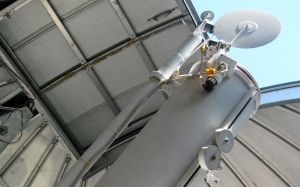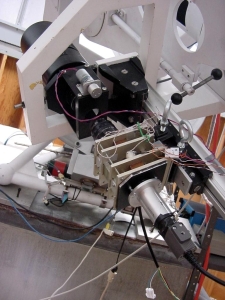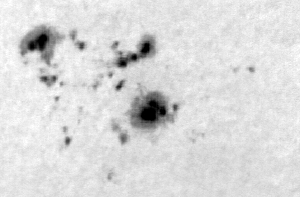Gregorian Vacuum Telescope
Full Disk Solar Telescope
Magneto Optical Filter
Gregorian Vacuum Telescope
The primary instrument of the program is a 35-cm Gregorian vacuum telescope designed specifically for solar observations. The reason to keep the telescope optics evacuated is that the incoming sunlight heats the internal structure and optics of the telescope and resulting air currents would cause image degradation (“internal seeing”).The H-alpha filter is used for our routine observations. It blocks almost all sunlight except for the band centered around the hydrogen line (Hydrogen-Alpha, H-alpha) located in the red part of the visible spectrum (at 6563Å). This wavelength is characteristic for plasma at temperatures of about 10 000 K, typical for the solar chromosphere.
about 10 000 K, typical for the solar chromosphere.
The primary detector is the Santa Barbara Instrument Group’s ST7 CCD camera. It has a CCD field of view roughly equal to that of the high-resolution region of the 35-cm telescope. The CCD can image in three modes, high resolution (1×1 pixel binning), medium resolution (2×2 binning), and low resolution (4×4 binning).
The high resolution mode is now used only on days of excellent seeing and we operate in the medium resolution mode at most times.
Full Disk Solar Telescope
The Full Disk Solar Telescope (FDST) is the newest instrument at PVSO, an independent telescope attached to the tube of the Gregorian vacuum telescope. It is equipped with a tunable grating that enables to observe at any wavelength of the solar visible spectrum. When the solar image moves across the entrance slit of the telescope it is followed by a CCD camera attached to a slide plate. That way we are able to obtain a full-disk monochromatic image of the Sun in about 2.5 minutes.
The FDST has already delivered first images, now we are working on the improvement of the data quality.
Magneto Optical Filter
The Magneto Optical Filter (MOF) is still under construction. Its first stage, how ever, has already been completed and tested. In this phase the MOF is able to record intensitygrams of the sun in the potassium 769.9nm line. With the completion of the second phase the MOF will be able to acquire simultaneous dopplergrams and magnetograms of the surface of the Sun.
In the current configuration, a telescope is used to form an image of a solar region of interest on a CCD camera. The MOF is placed between the telescope and the camera and filters the light by isolating the potassium line. The hearth of the MOF is a glass cell that contains potassium vapor, which is placed in a longitudinal magnetic field. The light which enters the cell passes first through a linear polarizer which transform the randomly polarized light into linear polarized light. In the presence of the magnetic field, the vapor will alter the polarization state of the potassium line. A second polarizer with the transmission axis perpendicular to the first is placed at the exit, blocking all the light but that modified by the vapor. The output consists of an image of the sun in the two wings of the potassium line. A second vapor cell, called the wing selector, will be added to the filter in the near future and will provide images of the Sun’s velocity and magnetic fields.

